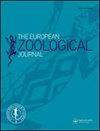在后代被遗弃后,短须燕鸥的雌性会再婚吗?
IF 1.6
4区 生物学
Q2 ZOOLOGY
引用次数: 1
摘要
在双亲本养育的物种中,亲本中的一方可以通过抛弃配偶来照顾后代来减轻亲本养育的成本。在许多鸟类中,尤其是翼形目鸟类中,单亲(通常是雌性)遗弃后代的现象时有发生。遗弃孩子的原因仍在争论中,目前还没有令人信服的证据表明这对男女双方都有好处和坏处。对逃兵来说,逃兵的好处可能包括在逃兵后不久就会与新伴侣产生抵触情绪。因此,遗弃可能会提高个体一生的繁殖成功率。在短须燕鸥中,几乎所有的雌鸟都会离开,大约一半的雌鸟在育雏期离开,另一半在羽化后离开。通过4年多的野外调查,我们调查了被遗弃的雌性短须燕鸥是否会继续生存和繁殖。我们假设有利的条件,如延长的繁殖季节和丰富的食物导致较高的繁殖成功率,将促使大多数雌性在遗弃后休息。然而,与这一预期相反,在育雏期间遗弃的雌性中只有5%(41只中有2只)留在研究区域并在该区域筑巢。这两只雌鸟的第一窝和第二窝之间大约间隔了50天。雌性在被遗弃后也会进行求爱行为(没有反抗)。因此,我们估计,在育雏期间被遗弃的雌性中,有15%(41只中有6只)随后参与了某种繁殖活动。因此,对于被抛弃的雌性须燕鸥来说,反抗似乎并不是一个主要的直接好处。这个物种的雌性可能在其他方面从遗弃中受益,但这些还没有被发现。本文章由计算机程序翻译,如有差异,请以英文原文为准。
Do females of Whiskered Tern Chlidonias hybrida renest after offspring desertion?
Abstract In species with biparental care, one parent may relieve him-/herself of the costs of parental care by deserting and leaving the mate to care for the offspring. Offspring desertion by a single parent, usually the female, occurs in many bird species, especially in Charadriiformes. The reasons for desertion are still being debated, and compelling evidence for the benefits and costs to either sex is not yet handed. The benefits of desertion for the deserter may include renesting with a new mate shortly after desertion. Therefore, desertion may enhance individual lifetime reproductive success. In Whiskered Tern Chlidonias hybrida almost all females desert, about half of females desert during chick-rearing period, the other half during the post-fledging period. Based on intensive fieldwork over a 4-year study, we investigated whether Whiskered Tern females remated and renested after desertion. We assumed that favourable conditions, such as an extended breeding season and food abundance resulting in a high breeding success would prompt most females to renest after desertion. In contrast to this expectation, however, only 5% of females that deserted during chick-rearing period (2 out of 41) remated and renested in the study area. About 50 days elapsed between the initiations of the first and second clutch by these two females. Females also participated in courtship behaviour after desertion (without renesting). We thus estimate that 15% (6 out of 41) of females that deserted during chick-rearing period were subsequently involved in some kind of breeding activity. Therefore, renesting does not seem to be a major direct benefit for deserting Whiskered Tern females. Females of this species probably benefit from desertion in other ways, but these have yet to be discovered.
求助全文
通过发布文献求助,成功后即可免费获取论文全文。
去求助
来源期刊

European Zoological Journal
Agricultural and Biological Sciences-Animal Science and Zoology
CiteScore
3.10
自引率
5.60%
发文量
80
审稿时长
30 weeks
期刊介绍:
The European Zoological Journal (previously Italian Journal of Zoology) is an open access journal devoted to the study of all aspects of basic, comparative and applied protozoan and animal biology at molecular, cellular, tissue, organ, organismal, population, and community-ecosystem level. Papers covering multiple levels of organization and integrative approaches to study animal form, function, development, ecology, evolution and systematics are welcome. First established in 1930 under the name of Il Bollettino di Zoologia, the journal now has an international focus, reflected through its global editorial board, and wide author and readership.
 求助内容:
求助内容: 应助结果提醒方式:
应助结果提醒方式:


